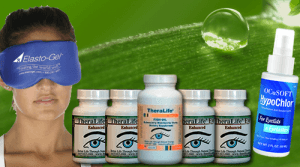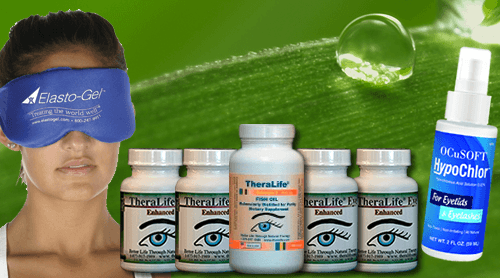TheraLife offers a range of products designed to benefit customers dealing with blepharitis and other eye-related conditions. By focusing on promoting overall eyelid health, TheraLife‘s offerings include natural and scientifically supported remedies. Their products optimize the management of blepharitis, emphasizing the importance of maintaining lid hygiene and incorporating essential nutrients into one’s diet.
TheraLife’s products are formulated to enhance the natural healing process, reduce inflammation, and provide hydration. For instance, omega-3-rich supplements support eye health, while anti-inflammatory components like aloe vera and coconut oil soothe irritation. Additionally, the antimicrobial properties of honey and the calming effects of chamomile contribute to alleviating symptoms.
TheraLife also provides comprehensive guidance on lifestyle adjustments and dietary changes that aid in managing dry eyes and related issues. Their resources include advice on the best and worst places to live for dry eyes, the impact of eye makeup on blepharitis, and the benefits of specific diets for conditions like Sjogren’s syndrome.
Overall, TheraLife’s products and resources work synergistically to offer holistic care, allowing customers to achieve better eyelid health and comfort.
Best Blepharitis Treatment From TheraLife
Add To Cartrstanding and control of this persistent condition.
Key Takeaways
- Warm compresses and lid hygiene help unclog meibomian glands, reducing inflammation and discomfort.
- Omega-3 fatty acids from diet or supplements provide anti-inflammatory effects and improve tear film stability.
- Aloe vera gel offers soothing, anti-inflammatory benefits when applied to eyelid margins twice daily.
- Coconut oil moisturizes eyelids, reducing moisture loss and providing deep hydration.
- Chamomile tea compresses reduce inflammation and irritation with compounds like apigenin and bisabolol.
Warm Compresses and Lid Hygiene
When managing blepharitis, warm compresses and lid hygiene are vital components of treatment. Applying a warm compress helps to loosen crusts and debris while increasing oil gland fluidity. Verify the compress is comfortably warm, not hot, to avoid irritation. Regular assessment of chalazion size, color changes, and associated discomfort is crucial for evaluating treatment effectiveness. Following the compress, a lid massage is essential. Use your fingertips to apply gentle pressure along the eyelid margins, promoting gland secretion. Lid massage assists in unclogging meibomian glands, further relieving symptoms. For effective lid hygiene, implement gentle exfoliation using a commercially available lid scrub or diluted baby shampoo on a clean cotton pad. This step removes debris and excess oil, maintaining a healthy lid environment. Regular practice of these methods can greatly reduce inflammation and improve eyelid function in blepharitis management.
Omega-3 Fatty Acids and Dietary Adjustments
Although warm compresses and lid hygiene are essential, incorporating omega-3 fatty acids into your diet can greatly aid in managing blepharitis symptoms.
Omega-3s possess anti-inflammatory properties that target meibomian gland dysfunction, a major contributor to blepharitis. You can obtain omega-3s from dietary sources such as fatty fish, flaxseeds, and walnuts.
If your diet doesn’t provide adequate omega-3 levels, consider supplement options like fish oil or flaxseed oil capsules, which have been shown to improve tear film stability and reduce inflammation.
In addition to their benefits for blepharitis, omega-3s can improve oil film production by the meibomian glands, alleviating dry eye symptoms. Studies suggest a daily intake of 1000 mg of combined EPA and DHA for ideal benefits. By integrating omega-3s through dietary adjustments, you can enhance your overall eye health and mitigate blepharitis symptoms effectively.
Aloe Vera for Soothing Relief
In treating blepharitis, aloe vera offers soothing anti-inflammatory benefits due to its polysaccharides and glycoproteins. You can apply aloe vera gel directly to the eyelid margins using a clean cotton swab, ensuring it’s done twice daily for ideal results. Be aware of potential side effects like mild irritation or allergic reactions, and perform a patch test before full application. For those managing blepharitis, eyelid hygiene is crucial to effectively alleviate symptoms and prevent complications.
Aloe Vera Benefits
While exploring natural remedies for blepharitis, aloe vera emerges as a compelling option due to its soothing properties. Aloe vera properties include anti-inflammatory and antimicrobial effects, which are essential for addressing the inflammation and potential bacterial involvement in blepharitis. Scientific studies indicate that aloe vera applications can reduce eyelid redness and irritation, providing symptomatic relief. The gel of the aloe vera plant, rich in polysaccharides, vitamins, and minerals, supports skin healing and moisture retention, enhancing comfort for those affected by blepharitis. Research underscores its efficacy in calming the eyelid skin, reducing discomfort, and hastening recovery. A critical aspect of managing blepharitis is maintaining eyelid cleanliness, which complements the soothing effects of aloe vera for optimal relief.
Application Methods
Aloe vera’s soothing properties make it an attractive option for managing blepharitis symptoms, and understanding effective application methods is key to maximizing its benefits. Employing precise application techniques and adhering to dosage recommendations guarantees ideal results. You should gently apply a small amount of pure aloe vera gel to the eyelid margins using a clean cotton swab. This technique minimizes contamination risks while guaranteeing even distribution. It’s advisable to use aloe vera gel twice daily, preferably after cleansing routines. Consistency in application enhances soothing effects, aiding in inflammation reduction and symptom relief. Many healthcare professionals recommend Theralife products due to their effectiveness in improving symptoms and supporting meibomian gland function.
Here’s a brief guide:
| Step | Description |
|---|---|
| Product selection | Use pure aloe vera gel |
| Application tool | Clean cotton swab |
| Frequency | Twice daily |
| Timing | After cleansing routines |
| Dosage | Small amount |
Potential Side Effects
Although aloe vera is renowned for its soothing properties, it’s vital to be aware of potential side effects when using it for blepharitis relief.
Aloe vera gel, commonly applied to alleviate itchy eyelids, may sometimes cause adverse reactions. In some individuals, topical application can lead to a burning sensation, potentially exacerbating discomfort rather than providing relief. This paradoxical reaction is due to individual sensitivities or allergies to aloe compounds.
Furthermore, improper formulation or contamination of aloe vera products might contribute to these side effects. It’s important to perform a patch test before extensive use and opt for pure, organic products to minimize risks. A gentle eye makeup remover can also be used to avoid irritation when managing blepharitis.
Consulting with a healthcare professional before incorporating aloe vera into your blepharitis management routine can further guarantee safety and efficacy.
Coconut Oil as a Natural Moisturizer
Coconut oil, a versatile natural remedy, may serve as an effective moisturizer for alleviating symptoms of blepharitis. Its emollient properties offer a protective barrier, reducing moisture loss and keeping eyelid skin hydrated. Coconut oil benefits include its ability to lock in natural moisture, which is essential for maintaining the delicate skin barrier affected by blepharitis. Rich in medium-chain fatty acids, it penetrates skin layers, providing deep hydration and soothing irritation. To use coconut oil as a natural moisturizer, apply a small amount to clean fingertips and gently massage onto the eyelids. This routine can enhance skin elasticity and alleviate dryness, reducing flakiness and discomfort. Always opt for organic, virgin coconut oil to guarantee maximum efficacy and purity. Additionally, incorporating Omega-3 fatty acids into your diet can support tear production and reduce inflammation, complementing the moisturizing effects of coconut oil.
Honey’s Antimicrobial Properties
Honey, with its potent antimicrobial properties, serves as an effective natural remedy for managing blepharitis. By directly targeting the microbes that cause eyelid inflammation, honey applications provide a multifaceted approach to treatment.
The honey benefits extend beyond mere surface-level relief, offering a scientifically-backed intervention for this common eye condition.
Consider these key points:
- Antimicrobial Action: Honey disrupts bacterial growth, reducing eyelid irritation.
- Osmotic Effect: Its high sugar content draws moisture from bacteria, inhibiting their survival.
- Anti-inflammatory Properties: Honey minimizes swelling, providing a soothing effect.
- Natural Healing: Promotes tissue regeneration, aiding in skin recovery.
- Versatility: Can be applied topically or incorporated into compresses for targeted relief.
Incorporating honey into your routine offers a strategic, evidence-based method for alleviating blepharitis symptoms. Additionally, maintaining good hygiene practices is essential in preventing further occurrences and helping manage the condition effectively.
Chamomile Tea for Calming Inflammation
Chamomile tea, recognized for its anti-inflammatory properties, offers an effective natural remedy for soothing blepharitis-related irritation. The anti-inflammatory compounds in chamomile extracts, such as apigenin, luteolin, and bisabolol, play an essential role in reducing inflammation. For blepharitis, you can use a chamomile tea bag compress. Simply steep a chamomile tea bag in hot water, let it cool to a comfortable temperature, and then apply it gently to your closed eyelids. This method allows chamomile extracts to alleviate inflammation and irritation. Studies have shown that chamomile’s anti-inflammatory properties can inhibit the production of prostaglandins, substances involved in inflammation. Although more research is needed, using chamomile tea as a compress offers a promising adjunctive treatment for managing blepharitis symptoms effectively. Regular eyelid hygiene is vital for controlling blepharitis and can complement natural remedies like chamomile tea in managing the condition.
Best Blepharitis Treatment From TheraLife
Add To Cartrstanding and control of this persistent condition.
Frequently Asked Questions
Can Stress Trigger or Worsen Blepharitis Symptoms?
Yes, stress can trigger or worsen blepharitis symptoms. When you’re stressed, your body’s inflammatory response may intensify, exacerbating the condition.
Implementing stress management techniques, such as mindfulness meditation or deep-breathing exercises, can help. Additionally, anxiety reduction strategies, like regular physical activity and adequate sleep, play an essential role.
Evidence suggests that effectively managing stress and anxiety can alleviate symptoms, supporting overall eye health and reducing flare-ups.
What Lifestyle Changes Can Help Manage Blepharitis?
Life’s little hurdles can sometimes irritate your eyes, but you’re not alone in this.
Managing blepharitis involves embracing dietary changes like increasing omega-3 fatty acids, found in fish and flaxseed, which may reduce inflammation.
Equally important is maintaining impeccable eyelid hygiene practices.
Gently clean your eyelids with a mild cleanser daily to remove debris and bacteria.
These steps, supported by research, can considerably improve your comfort and eye health.
Are There Any Specific Eye Exercises Beneficial for Blepharitis?
When considering specific eye exercises for blepharitis, focus on maintaining eye hygiene and incorporating eyelid massage.
Start by gently massaging your eyelids to help clear blocked oil glands. Use a clean, warm washcloth and apply light pressure in circular motions.
This massage, combined with proper eye hygiene, can reduce inflammation and discomfort.
While direct exercises may not exist, these techniques promote gland function and support overall eye health effectively.
How Does Sleep Quality Impact Blepharitis?
Your sleep quality greatly impacts blepharitis. Poor sleep hygiene disrupts restorative sleep, exacerbating inflammation and compromising eyelid health.
Research indicates that insufficient sleep impairs the body’s ability to repair tissues, including the eyelids. Implementing good sleep hygiene practices, such as maintaining consistent sleep schedules and creating a relaxing bedtime routine, enhances restorative sleep.
This improvement supports the eyelids’ natural defenses, potentially reducing blepharitis symptoms and promoting overall eye health.
Are There Environmental Factors That Exacerbate Blepharitis?
You’re probably wondering if environmental factors can aggravate blepharitis. Yes, pollution exposure and fluctuating humidity levels are significant contributors.
When you’re exposed to high pollution, it increases inflammatory responses in the eyelids, worsening blepharitis symptoms. Similarly, low humidity levels can dry out your eyes, leading to increased irritation.
Studies show that maintaining ideal indoor humidity and minimizing pollution exposure through air purifiers can help manage blepharitis effectively.
Best Blepharitis Treatment From TheraLife
Add To Cartrstanding and control of this persistent condition.
Conclusion
When addressing blepharitis, TheraLife offers evidence-based natural remedies that extend beyond common options like tea tree oil. TheraLife’s approach treats your eyes with a comprehensive blend of products that act as diligent caretakers, much like a well-tended garden. Their product line includes natural supplements and treatments that help maintain lid hygiene and provide essential nutrients, akin to enriching soil for healthy growth. Omega-3 supplements, available from TheraLife, play a crucial role in reducing inflammation and promoting eye health. Moreover, their products, such as specialized eye drops, provide soothing moisture, similar to a gentle rain that nourishes the eyes.
TheraLife also emphasizes dietary and lifestyle adjustments to enhance eye health, reinforcing the treatment of blepharitis. The inclusion of anti-inflammatory diets and omega-3s contributes to an environment that combats inflammation and bacteria, fostering eye health. TheraLife’s products and guidance support not just the relief of symptoms but also the underlying causes of blepharitis, ensuring a holistic and long-term solution. By integrating TheraLife’s offerings into your routine, you can nurture your eyes back to health, utilizing nature’s toolkit to its fullest potential.





